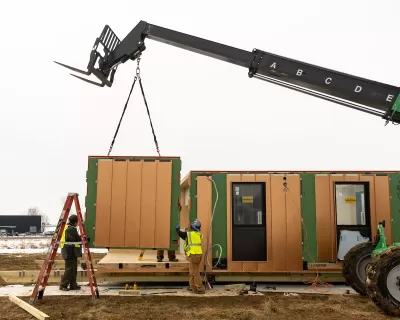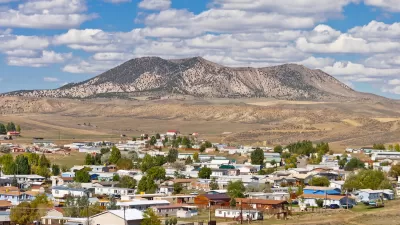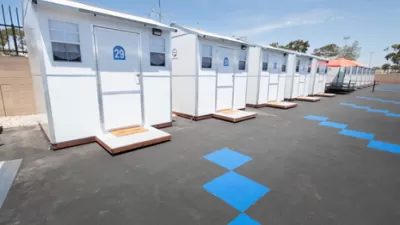Two bills currently moving through Congress could make mass production of prefabricated, affordable housing possible on a large scale.

At this summer’s Democratic National Convention, former President Barack Obama was among the few speakers to address what ought to be one of the major hot-button issues of this campaign season: America’s ongoing housing crisis, and the staggering housing deficit — now standing at nearly four million units nationwide — that keeps driving prices upward. “If we want to make it easier for more young people to buy a home,” Obama told the crowd in Chicago, “we need to build more units and clear away some of the outdated laws and regulations that make it harder to build homes for working people in this country.” In the intervening weeks, Vice President Kamala Harris has also made the housing crisis and the creation of millions of new homes a cornerstone of her campaign and a promise for her first weeks in office.
We couldn’t agree more.
As architects, we've witnessed firsthand how confusing and restrictive building codes have stymied well-intentioned efforts from both the public and private sectors to find a way out of the present impasse. In particular, we've watched with growing frustration as outdated local laws have stood in the way of one of the key instruments in the fight to create more housing at lower cost prefabrication and modular construction, a proven approach that's more powerful than ever thanks to advances in digital and material technology. Fortunately, new federal legislation is now being considered that could unleash the true power of factory-built housing: two similar bills, both with broad bipartisan support, are currently pending in the U.S. House and Senate, just waiting for committee approval. The passage of either one is essential to the future of American housing. By striking the single sentence in a fifty-year-old HUD rule that establishes a requirement that all “manufactured homes” be attached to a chassis, or trailer, 50 years of innovation in modular and prefabrication can be unlocked and applicable to HUD’s building codes, making mass production of affordable housing and financing available at a large scale.
‘Prefabricated‘ is not a dirty word
Empowering modular builders is not a controversial idea. The fact is that prefabrication is and has long been a key component of our nation’s housing production system: since as early as the 1900s, when 70,000 families bought mail-order dream homes straight out of the Sears catalog, Americans have been living in buildings assembled from a kit of readymade parts. By the end of the Second World War, the evolution towards fully modular construction — with factory-built homes arriving in complete, combinable units — was well underway, with the widespread use of military-issue Quonset huts and new companies like Lustron catering to the rapidly expanding suburbs. Today, permanent modular construction is a $12-billion industry, with some 20 million Americans presently living in off-site manufactured homes. The reason why is obvious: according to a recent study by the Los Angeles Business Journal, modular homes cost as much as 14 percent less than their conventional counterparts. For today’s cash-strapped house hunters, the savings are impossible to ignore.
And the potential for even greater savings is just around the corner. The pace of innovation in the contemporary modular sector is faster than at any time since mid-century. Tech giants like Google and Meta have jumped into the field in recent years, and modular startups have been debuting exciting new projects in places as varied as Pittsburgh, Pennsylvania and Portland, Oregon. At our design firm, DXA Studio, we’ve teamed up with numerous manufacturers on a new line of modular single-family homes that can be ready for occupancy in less than one day and can be integrated with sophisticated systems-management technology to optimize occupants’ health and comfort, as well as to reduce their carbon footprint. Novel materials and emerging AI design techniques augur still more breakthroughs to come, bringing modular housing fully into the mainstream.
Expanding HUD authority beyond mobile homes
But there’s a problem; more accurately, there are thousands of them. Under a federal statute in place since 1974, the United States Department of Housing and Urban Development (HUD) is empowered to issue universal building codes for what it terms “manufactured homes,” provided that those homes are transported on “a permanent chassis.” Effectively, that means that HUD can override local regulations to allow low-cost, prefab housing anywhere it’s needed — but only if it comes on wheels, in the form of mobile homes. In the absence of a broader national policy, factory-built housing providers are subject to a complex quilt of state, county, and municipal laws, making it prohibitively difficult to achieve the kind of standardization and scale that would bring production costs down. Expanding HUD’s authority would allow modular builders to stop starting from scratch every time and to start making a serious dent in the nation’s housing deficit.
That’s what two bills now making their way through Congress promise to do. In the House, the Expansion of Attainable Homeownership Through Manufactured Housing Act — introduced by Rep. John Rose,R-TN — and in the Senate, the ROAD to Housing Act — drafted by the office of Sen. Tim Scott,R-SC) — alter the language of the fifty-year-old HUD rule to include a wider array of modular and prefabricated structures. As Sen. Scott said in March when discussing his proposal in the Senate, “It’s not ‘partisan’ to encourage innovation and competition in federal programs to better support families living in manufactured housing.” He’s right: in an era of polarizing politics and legislative paralysis, Rep. Rose has managed to attract endorsements from across the aisle, with Democrats like Rep. Lou Correa, D-CA, and Rep. Marie Gluesenkamp Perez, D-WA, signing on as cosponsors. In the White House, HUD Secretary Marcia Fudge signaled her support for more manufactured housing, describing it as “an innovative solution to the affordable housing supply crisis.”
All that remains now is to get one or the other of these proposals to a floor vote. The chairmen of the Senate Banking Committee and the House Financial Services Committee need to take action as soon as possible, referring the bills to their respective leadership so that they can be approved either as standalone legislation or as part of a larger omnibus spending agreement down the road. Fortunately, momentum seems to be building. President Biden included a version of the regulatory change in his draft budget earlier this year, bringing us tantalizingly close to our goal. The most important thing now is to ensure that Americans everywhere recognize the vital opportunity now before them, and insist that their elected officials seize it immediately.
Our country’s housing crisis will not solve itself. Using an old idea, and some basic common sense, we can build a new generation of American housing.
Jordan Rogove, AIA, LEED AP, SARA is an architect who approaches his work with a belief in the power of architecture to positively influence the lives of all who engage with it. He co-founded DXA Studio with his partner Wayne Norbeck in 2011.

Study: Maui’s Plan to Convert Vacation Rentals to Long-Term Housing Could Cause Nearly $1 Billion Economic Loss
The plan would reduce visitor accommodation by 25,% resulting in 1,900 jobs lost.

North Texas Transit Leaders Tout Benefits of TOD for Growing Region
At a summit focused on transit-oriented development, policymakers discussed how North Texas’ expanded light rail system can serve as a tool for economic growth.

Using Old Oil and Gas Wells for Green Energy Storage
Penn State researchers have found that repurposing abandoned oil and gas wells for geothermal-assisted compressed-air energy storage can boost efficiency, reduce environmental risks, and support clean energy and job transitions.

Private Donations Propel Early Restoration of Palisades Playground
Los Angeles has secured over $1.3 million in private funding to restore the Pacific Palisades playground months ahead of schedule, creating a modern, accessible space that supports community healing after recent wildfires.

From Blight to Benefit: Early Results From California’s Equitable Cleanup Program
The Equitable Community Revitalization Grant (ECRG) program is reshaping brownfield redevelopment by prioritizing projects in low-income and environmental justice communities, emphasizing equity, transparency, and community benefits.

Planting Relief: Tackling Las Vegas Heat One Tree at a Time
Nevada Plants, a Las Vegas-based nonprofit, is combating the city’s extreme urban heat by giving away trees to residents in underserved neighborhoods, promoting shade, sustainability, and community health.
Urban Design for Planners 1: Software Tools
This six-course series explores essential urban design concepts using open source software and equips planners with the tools they need to participate fully in the urban design process.
Planning for Universal Design
Learn the tools for implementing Universal Design in planning regulations.
Ascent Environmental
Borough of Carlisle
Institute for Housing and Urban Development Studies (IHS)
City of Grandview
Harvard GSD Executive Education
Toledo-Lucas County Plan Commissions
Salt Lake City
NYU Wagner Graduate School of Public Service





























